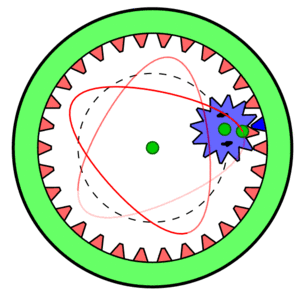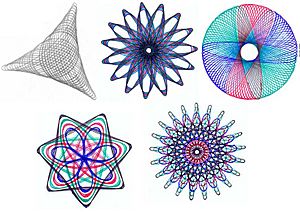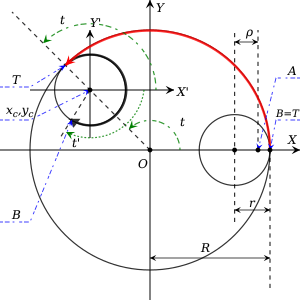Spirograph facts for kids

Spirograph set (early 1980s UK version)
|
|
| Inventor(s) | Denys Fisher |
|---|---|
| Company | Hasbro |
| Country | United Kingdom |
| Availability | 1965–present |
| Materials | Plastic |
Spirograph is a geometric drawing device that produces mathematical roulette curves of the variety technically known as hypotrochoids and epitrochoids. The well known toy version was developed by British engineer Denys Fisher and first sold in 1965.
The name has been a registered trademark of Hasbro Inc. since 1998 following purchase of the company that had acquired the Denys Fisher company. The Spirograph brand was relaunched worldwide in 2013, with its original product configurations, by Kahootz Toys.
Operation
The original US-released Spirograph consisted of two differently sized plastic rings (or stators), with gear teeth on both the inside and outside of their circumferences. Once either of these rings were held in place (either by pins, with an adhesive, or by hand) any of several provided gearwheels (or rotors)—each having holes for a ballpoint pen—could be spun around the ring to draw geometric shapes. Later, the Super-Spirograph introduced additional shapes such as rings, triangles, and straight bars. All edges of each piece have teeth to engage any other piece; smaller gears fit inside the larger rings, but they also can rotate along the rings' outside edge or even around each other. Gears can be combined in many different arrangements. Sets often included variously colored pens, which could enhance a design by switching colors, as seen in the examples shown here.
Beginners often slip the gears, especially when using the holes near the edge of the larger wheels, resulting in broken or irregular lines. Experienced users may learn to move several pieces in relation to each other (say, the triangle around the ring, with a circle "climbing" from the ring onto the triangle).
Mathematical basis
Consider a fixed outer circle  of radius
of radius  centered at the origin. A smaller inner circle
centered at the origin. A smaller inner circle  of radius
of radius  is rolling inside
is rolling inside  and is continuously tangent to it.
and is continuously tangent to it.  will be assumed never to slip on
will be assumed never to slip on  (in a real Spirograph, teeth on both circles prevent such slippage). Now assume that a point
(in a real Spirograph, teeth on both circles prevent such slippage). Now assume that a point  lying somewhere inside
lying somewhere inside  is located a distance
is located a distance  from
from  's center. This point
's center. This point  corresponds to the pen-hole in the inner disk of a real Spirograph. Without loss of generality it can be assumed that at the initial moment the point
corresponds to the pen-hole in the inner disk of a real Spirograph. Without loss of generality it can be assumed that at the initial moment the point  was on the
was on the  axis. In order to find the trajectory created by a Spirograph, follow point
axis. In order to find the trajectory created by a Spirograph, follow point  as the inner circle is set in motion.
as the inner circle is set in motion.
Now mark two points  on
on  and
and  on
on  . The point
. The point  always indicates the location where the two circles are tangent. Point
always indicates the location where the two circles are tangent. Point  , however, will travel on
, however, will travel on  , and its initial location coincides with
, and its initial location coincides with  . After setting
. After setting  in motion counterclockwise around
in motion counterclockwise around  ,
,  has a clockwise rotation with respect to its center. The distance that point
has a clockwise rotation with respect to its center. The distance that point  traverses on
traverses on  is the same as that traversed by the tangent point
is the same as that traversed by the tangent point  on
on  , due to the absence of slipping.
, due to the absence of slipping.
Now define the new (relative) system of coordinates  with its origin at the center of
with its origin at the center of  and its axes parallel to
and its axes parallel to  and
and  . Let the parameter
. Let the parameter  be the angle by which the tangent point
be the angle by which the tangent point  rotates on
rotates on  , and
, and  be the angle by which
be the angle by which  rotates (i.e. by which
rotates (i.e. by which  travels) in the relative system of coordinates. Because there is no slipping, the distances traveled by
travels) in the relative system of coordinates. Because there is no slipping, the distances traveled by  and
and  along their respective circles must be the same, therefore
along their respective circles must be the same, therefore
or equivalently,
It is common to assume that a counterclockwise motion corresponds to a positive change of angle and a clockwise one to a negative change of angle. A minus sign in the above formula ( ) accommodates this convention.
) accommodates this convention.
Let  be the coordinates of the center of
be the coordinates of the center of  in the absolute system of coordinates. Then
in the absolute system of coordinates. Then  represents the radius of the trajectory of the center of
represents the radius of the trajectory of the center of  , which (again in the absolute system) undergoes circular motion thus:
, which (again in the absolute system) undergoes circular motion thus:
As defined above,  is the angle of rotation in the new relative system. Because point
is the angle of rotation in the new relative system. Because point  obeys the usual law of circular motion, its coordinates in the new relative coordinate system
obeys the usual law of circular motion, its coordinates in the new relative coordinate system  are
are
In order to obtain the trajectory of  in the absolute (old) system of coordinates, add these two motions:
in the absolute (old) system of coordinates, add these two motions:
where  is defined above.
is defined above.
Now, use the relation between  and
and  as derived above to obtain equations describing the trajectory of point
as derived above to obtain equations describing the trajectory of point  in terms of a single parameter
in terms of a single parameter  :
:
(using the fact that function  is odd).
is odd).
It is convenient to represent the equation above in terms of the radius  of
of  and dimensionless parameters describing the structure of the Spirograph. Namely, let
and dimensionless parameters describing the structure of the Spirograph. Namely, let
and
The parameter  represents how far the point
represents how far the point  is located from the center of
is located from the center of  . At the same time,
. At the same time,  represents how big the inner circle
represents how big the inner circle  is with respect to the outer one
is with respect to the outer one  .
.
It is now observed that
and therefore the trajectory equations take the form
Parameter  is a scaling parameter and does not affect the structure of the Spirograph. Different values of
is a scaling parameter and does not affect the structure of the Spirograph. Different values of  would yield similar Spirograph drawings.
would yield similar Spirograph drawings.
The two extreme cases  and
and  result in degenerate trajectories of the Spirograph. In the first extreme case, when
result in degenerate trajectories of the Spirograph. In the first extreme case, when  , we have a simple circle of radius
, we have a simple circle of radius  , corresponding to the case where
, corresponding to the case where  has been shrunk into a point. (Division by
has been shrunk into a point. (Division by  in the formula is not a problem, since both
in the formula is not a problem, since both  and
and  are bounded functions).
are bounded functions).
The other extreme case  corresponds to the inner circle
corresponds to the inner circle  's radius
's radius  matching the radius
matching the radius  of the outer circle
of the outer circle  , i.e.
, i.e.  . In this case the trajectory is a single point. Intuitively,
. In this case the trajectory is a single point. Intuitively,  is too large to roll inside the same-sized
is too large to roll inside the same-sized  without slipping.
without slipping.
If  , then the point
, then the point  is on the circumference of
is on the circumference of  . In this case the trajectories are called hypocycloids and the equations above reduce to those for a hypocycloid.
. In this case the trajectories are called hypocycloids and the equations above reduce to those for a hypocycloid.
See also
 In Spanish: Espirógrafo para niños
In Spanish: Espirógrafo para niños














![\begin{align}
x(t) &= R\left[(1 - k)\cos t + lk\cos \frac{1 - k}{k}t\right],\\
y(t) &= R\left[(1 - k)\sin t - lk\sin \frac{1 - k}{k}t\right].\\
\end{align}](/images/math/5/c/5/5c5fc99ef35d8003c3c9825c4d16d939.png)